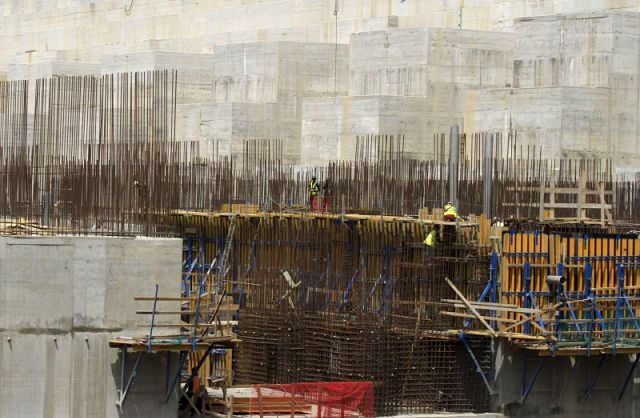 Construction workers in a section of Ethiopia's Grand Renaissance Dam, March 31, 2015. (Photo: Reuters)
Construction workers in a section of Ethiopia's Grand Renaissance Dam, March 31, 2015. (Photo: Reuters)
By Harry Verhoeven
In 1991, as the Cold War drew to an end, the only African country that had never been colonized by European imperialists was but a pale reflection of the Great Ethiopia that generations of the kingdom’s monarchs had pursued. A million people lay dead following two decades of civil war. Secessionist movements in the provinces clamored for self-determination. The economy was in tatters, and another catastrophic famine loomed. The world came to associate Ethiopia with images hoards of starving children, and the country’s regional and domestic decline opened questions about its very survival.
Nationalist historians trace the Ethiopian state’s roots to the second millennium BCE. With the story of King Solomon and the Queen of Sheba as one of its founding myths, Ethiopia’s history has between entwined with the development of the Abrahamic faiths: the Jewish presence in the Ethiopian Highlands predates the destruction of the Temple; Ethiopian Orthodox Christians claim that the Ark of the Covenant is located in Axum; and the first Muslim hijra, or flight from Mecca to escape religious persecution, was to Ethiopia. Mystical ancestry and military greatness provided legitimacy to Ethiopia’s rulers for centuries as they controlled their formidably diverse empire through a policy of violent internal assimilation and external expansion.
But ideas of that greatness lay shattered as rebel soldiers from the countryside marched on Addis Ababa in May 1991 and overthrew the (formerly Soviet sponsored) dictatorship of Mengistu Haile Mariam. The leftist liberation movement promised a constitution that would give self-determination to Ethiopia’s ninety-plus nations and nationalities and address the political-economic inequities that had torn the country apart, but observers were sceptical about the ability of the Horn of Africa’s once mightiest empire to reconstitute itself. When the northeastern territory of Eritrea voted for and got independence in 1993, it not only cut Ethiopia off from the sea, but also risked triggering cascading claims for self-rule.
A quarter-century on, though, the mood in Addis Ababa could not be more changed. Between 2001 and 2012–13, Ethiopia’s economy grew more than seven percent per year on average. It was the only African country to move at a pace comparable to the East Asian tigers—and to do so without a hydrocarbons boom or a huge mining sector. The economic miracle resulted in real pro-poor growth, lifting millions of people out of the vicious cycle of poverty, hunger, and poor health. While the country’s population soared from roughly 40 million in the 1980s to nearly 100 million today, it achieved the 2000–15 Millennium Development Goals for child mortality and is likely to also meet them for combating HIV/AIDS and rolling back malaria. Ethiopia is also making giant strides tackling income volatility and illiteracy. And, with sequential bumper harvests of Ethiopia’s staple crop, tef (a cereal similar to millet), millions of smallholder farmers might well be able to escape the productivity traps that historically have kept them in abject poverty.
Read more at foreignaffairs.com »
—
Join the conversation on Twitter and Facebook.

























